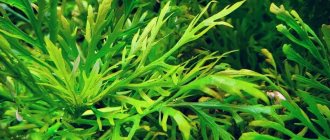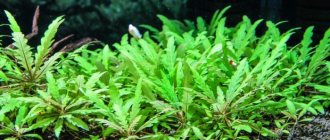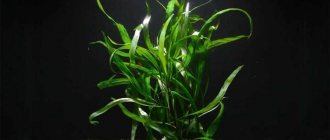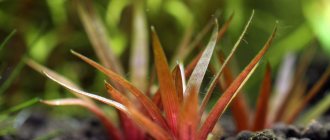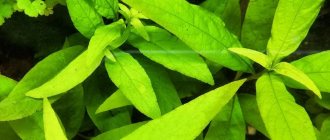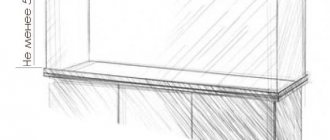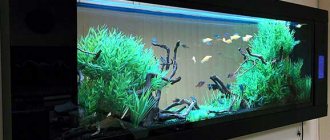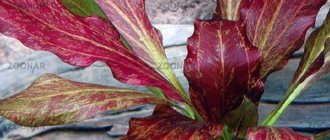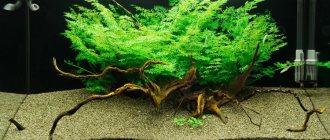Hygrophila Polysperma, along with Willow, Marble and Corimbosa, Schisandra is the brightest representative of its genus. It grows well and is recommended for growing for beginners.
In addition to its excellent decorative qualities, this plant has a beneficial effect on the aquatic environment, as it processes nitrates and filters water. And its dense leaves serve as “nests” for fish eggs.
Hygrophiles are one of the most “capacious” and confusing groups in terms of classification. Great variability led to the fact that scientists attributed the same specimen not only to different species, of which there are about 100, but also to genera. And this is not surprising.
Representatives of Hygrophyla and Nomaphila have a lot in common, so they can sometimes be difficult to identify. Fortunately, the roughness of systematization bypassed Hygrophila Polysperma. The plant has been well studied and is used throughout the aquarium hobby.
This culture easily forms new forms. There are several artificially bred varieties that differ in the color of the leaf plate. Some of the species are fixed in culture:
- Rosanervig - rich emerald pink leaves and pale pink veins.
- Ceylon - oblong leaf plates of yellow-brown color.
- Broad leaf - wide oval dark green foliage.
The plant forms lush thickets reminiscent of mangrove forests. In good light it takes on a reddish tint.
Plant morphology
Hygrophila polyspermous looks like a creeping algae with a long stem. The name of the plant is formed from 2 Greek words: hygros - “wet” and phileo - “love”. The species was described in 1867.
Main characteristics:
- Family - Acanthus.
- Genus - Hygrophila.
- The stem is smooth, 30 to 40 cm long.
- The color of the inflorescences is pale blue. Blooms exclusively in the air.
- The leaves are pointed, up to 8 cm long and up to 1.5 cm wide. They are arranged in pairs, symmetrically opposite each other. Each subsequent pair is formed perpendicular to the previous one. The color of the leaf blade is light green, the reverse side is pale silver.
Hygrophila Polysperma, along with Anubias, is one of the hardy species.
Botanical description and natural habitat
Belongs to the Acanthus family, genus Flowering Dicotyledons. There are about 100 varieties of Hygrophila, which differ from each other in the color and shape of the leaves, as well as the size of the bushes. The homeland of this plant is considered to be Southeast Asia, where a humid tropical climate prevails. Moreover, it can grow both on land and in water, being essentially an amphibian. Prefers bodies of water with a slow flow (small rivers, channels) or without it (wetlands, for example, lakes and ponds). Favorite location: shallow water with plenty of sun, avoids shady areas. The optimal temperature range for growth is from +18…+30 °C. Loves nutritious soil.
Outwardly it looks like bushes with small, long, elongated leaves arranged in pairs. The color in natural conditions is rich green on top, and silver on the back. They can reach 20 cm in length and about 2 cm in width. Under optimal conditions, the plant can grow up to 20-30 cm in height, and up to 15 cm to the sides.
It propagates vegetatively, that is, by parts of the stem or leaves. Due to the almost continuous cycle of rebirth, the exact lifespan is impossible to determine.
Distribution area
The plant is native to the waters of Southeast Asia.
Distributed in almost all tropical regions. This culture is found in rivers and lakes of the USA and China, swamps of India and Bhutan.
In its natural habitat it is considered a weed. Prefers wet, marshy areas and tolerates flooding well.
Diseases and pests
If the rules for caring for Hygrophila are violated, it grows greatly and protrudes above the water level. Therefore, it is important to monitor its length and trim overgrown bushes in time. When outside the aquatic environment, the sheets can get burned and turn yellow; in this case, reduce the intensity of artificial lighting and remove them from direct sunlight (in natural conditions).
When the bush weakens, the stem becomes brittle and the foliage turns pale, you should pay attention to the parameters of the aquatic environment and normalize them. After this, she will return to her original beauty.
Hygrophila is a very beautiful and unusual plant, which, with proper care and maintenance, will delight you with its appearance for many years.
Growing and care
Even a beginner can cope with breeding hygrophiles. The plant is not demanding in terms of living conditions, but when growing it is important to take into account several points.
We offer you a small cheat sheet:
- Hygrophila Polysperma is a swamp crop that can be grown in an aquarium, wet greenhouse and paludarium.
- It grows submerged or protrudes slightly from the water. Blooms exclusively in the air.
- It is advisable not to grow it in a floating state, since the leaves begin to shrink and the rhizome develops poorly.
- The plant is used as a background plant to decorate the background. It is practically not used to create an aquascape.
- Hygrophila needs to be pruned regularly. This manipulation helps slow growth and has a positive effect on appearance.
- Due to its large size, it is not suitable for small aquariums.
- Most aquarium animals are not interested in this plant. But this pattern does not apply to goldfish and cichlids, which love to feast on succulent foliage.
- Hygrophila Polysperma reaches its greatest decorative value at the surface of the water, when the leaves touch the water surface, but do not crawl out.
- When planting, the branches should be rooted onto 2 whorls of leaf blades and secured in the soil. This measure is due to the fact that the root system of plants develops more slowly than the leaves, and the stems have good buoyancy.
- The recommended distance between plants is from 5 to 10 cm. This guarantees comfortable growth and protects the rhizomes from intertwining.
Hygrophila Polysperma grows quickly and forms beautiful bushy thickets in which the fry love to hide.
Optimal water parameters
The plant prefers a slightly acidic soft environment. Regular water changes are required.
Recommended settings:
- temperature - 24-38°C;
- pH 5-7;
- General hardness - 4-8 ° dH.
If the water temperature drops below 22°C, the growth of hygrophila stops. When the hardness is above 8°, the leaf plates located at the top become smaller.
The supply of carbon dioxide is not necessary, since it stimulates the vigorous growth of this plant. Of course, if the aquarium contains crops that require CO2, an exception should be made.
The dry matter of plants consists of 46% carbon, which they obtain from water. In the aquatic environment it is found in small quantities, so aquarists additionally enrich the artificial biotope with this element. But Echinodorus, Cryptocoryne, Hygrophila and some varieties of Ludwigia do not need large amounts of carbon dioxide.
Lighting requirements
The key parameter regarding light is intensity, which is measured in Lumens. Other characteristics, such as spectrum, are important but secondary. Artificial and natural lighting is suitable for growing Hygrophila Polysperma.
- But the plant does not like to be exposed to direct sunlight. Shade is preferable. The plant can withstand periods of prolonged shading, but this negatively affects its decorative characteristics.
- Lighting intensity - from 70 to 100 Lm/l. Daylight hours are up to 12 hours. To organize artificial lighting, fluorescent lamps are suitable at the rate of 0.5 W per 1 liter of tank volume.
Soil requirements
It is advisable to plant Hygrophila Polysperma in naturally silted soil.
The amount of nutrients contained there is sufficient for the normal functioning of the plant.
Sand or small pebbles can be used as soil.
The need for feeding
The food is predominantly groundwater.
The application of soil fertilizers has a positive effect on the appearance of plants, helps to shorten the internodes, which improves their decorative appearance.
If there are a large number of hygrophiles in the aquarium, they should be fed weekly with a complex of mineral fertilizers at the rate of 2 g per 10 liters of water. If solutions for horticultural crops are used, the concentration must be reduced by 100 times.
Reproduction
Hygrophila is a fast-growing and unpretentious plant that is propagated by cuttings. During active growth, many aerial roots are formed on its stem, which increase the absorption of nutrients from the aquatic environment.
To get yourself
standing plant, it is enough to separate a small cutting from it, which has 4-5 whorls of leaves and aerial roots, and then plant the shoot in the ground to a depth of 1-2 cm. The main root part of young shoots develops within one week.
It is recommended to take cuttings from mature plants that are already well formed: they have a developed root system and a long stem.
In order for the mother hygrophila to retain its beautiful decorative appearance, it is advisable to make the cut as close to the whorl as possible. In this case, the adult plant will produce a new shoot from the upper pair of leaves, covering the cutting site.
It is recommended to plant Hygrophila polysperma in groups at points with the most intense lighting. Thanks to the rapid growth and simple propagation process, within one month from 2-3 mother plants you can create beautiful thickets that will become both a decorative decoration and reliable protection for fry and small living creatures of the reservoir. Let's look at other species that are popular among aquarists.
Useful lifehacks
For successful cultivation, we recommend that you familiarize yourself with the advice of experienced aquarists:
- The plant may die from lack of lighting. Moreover, it reacts more strongly to a decrease in light intensity than to a lack of iron or calcium.
- If the daylight hours are less than 12 hours, the leaf blades decrease in volume.
- Like all hygrophiles, polyspermous has one annoying feature. When the stem reaches the surface of the water, the plant sheds its leaves on the lower part. This effect is especially typical for hard water. As a result, it becomes like a palm tree with a bare trunk and lush foliage. To make the water landscape more aesthetically pleasing, you need to place the hygrophila behind driftwood or stones. This will help decorate the bald stem.
Mr. Tail recommends: varieties
A large number of varieties have now been bred for keeping in aquarium conditions. Among the most popular are the following.
Polyspermous marbled Hygrophila
Most popular among aquarists with little experience. The leaves are oval in shape, reach 6 cm in length and 3 cm in width. They are colored light green in water and red-burgundy in air. Thanks to the veins of white, orange, red, yellow, it produces an unusual pattern, for which it is valued. The stem is elongated. The bushes grow up to 40 cm in height and 10 cm in circumference.
Feels good in any aquarium, regardless of its size. With sufficiently intense lighting, the species tends to turn red foliage. For this variety, it is preferable to use fairly fine soil; the diameter of the grains of sand should be no more than 3-4 mm. With prolonged (at least 10 hours) and intense lighting it grows more abundantly.
If there is a lack of light, it begins to stretch in length and the size and number of leaves decreases, which spoils the appearance of the plant.
Aquadesign
If a hygrophila appears in the hands of an aquarist, then he may no longer think about how to create an attractive background for the aquarium. No more photo panels or painting of the back wall. By placing several hygrophiles along the back of the aquarium, after a while you can get an excellent background of natural greenery. Hygrophiles value this ability, which is why it is widely used in aquatic design.
It is not recommended to plant hygrophila in the center or on the outside of the aquarium, as it will quickly begin to grow in width and height and block the view. In addition, the resulting dense thickets will interfere with other inhabitants, including fish and invertebrates.
It is better to place compact decorations in the foreground, such as driftwood, artificial algae, polyps, stones and decorative elements.
Hygrophila polysperma - a popular plant in aquadesign
Do not forget about monthly thinning of hygrophiles. When the vertical carpet becomes too bulky, some branches are cut off at the root.
Cut shoots can be either propagated or disposed of. And the aquarium will become freer for a while.
Types of popular forms
Hygrophila is a very interesting plant. She feels good both on the shore and under water. The plant’s ability to metamorphose is amazing - depending on the environment, the type of leaf blade, type of nutrition, and reproduction change. Aquascaping uses unpretentious plant species that have decorative value.
Hygrophila varifolia
Sinema, or Hygrophila varifolia, is prized for its beautifully carved leaf blades. On a tall, strong stem, the leaves are located oppositely, which forms a compact silhouette. With different light flux densities, the shape of the leaf blade undergoes metamorphosis .
Insufficient lighting - the leaves of the plant become smaller and acquire a more rounded shape. If the intensity of the light flux increases, the sheet becomes longer, larger and deep cuts appear on it. Sometimes on one bush you can find leaves of both forms, which gave rise to the name “variegated or dimorphic”.
The plant has a beautiful yellowish-green color. Thanks to its tall growth, Hygrophila looks beautiful in the middle of the aquarium, where it forms dense thickets. In nano-aquariums it can be the center of the composition, since the bush is compact and will not take up too much space.
The blue one doesn’t have to be dripped, and then it floats in the water column. Propagated by cuttings. Once you cut the stem at the required height and stick the free lower part into the ground or leave the shoot to float, a root system will form over time.
Rapid growth and significant (up to 30 cm) dimensions require a large volume of water - 60-70 liters. Otherwise, you will have to constantly trim the bush. At low water levels, part of the hygrophila can rise above its surface. When exposed to air, leaves become covered with a denser cuticle, become tougher, darker, and villi appear on their surface.
Hygrophila loosestrife
Tall (up to 60 cm) plant with long (up to 10 cm), narrow leaves. With a lack of lighting, the leaves, like those of other species, become smaller, their shape approaches oval, and their color becomes paler. If the lighting is more intense, then the large veins of the leaves acquire a red-brown color.
Intensive growth leads to the fact that hygrophila can rise above the water level, and white flowers appear in the internodes. Externally, Hygrophila willow can be confused with another species - Hygrophila lacustrine.
Hygrophila polysperma
A very popular look. Found in almost all aquariums. The long, rigid stem can grow up to 50 cm. The leaves are oblong with rounded ends, 5-6 cm long. The stems are erect and can bush, forming lush thickets.
At low light intensity, the color of the leaf blade changes from light green to reddish. This beautiful amphibious plant thrives in the humid atmosphere of greenhouses.
Schisandra or nomafila straight
Hygrophila Schisandra is two morphological forms of one plant, which is why they have so many names - Nomaphila stricta, Hygrophila stricta. The stems are strong, tough, dark in color. Wide oval leaves are attached to them in pairs.
The length of the leaf blade (12 cm) is twice the width (4-5 cm). Leaf color varies from light green with a yellowish tint to deep green. When planting several plants in one hole, it quickly forms dense openwork thickets.
The second morph of Schisandra Nomaphila spec. Almost no different in appearance. Only its leaves have a slightly more rounded shape and, with a lack of light, become reddish at the petiole and on the stem. In the air it blooms with small tubular flowers collected in an inflorescence-brush of lilac or blue color.
Based on these species, stable patterned forms have been developed that have a white or yellow color along the leaf veins. Hybrid forms of the plant constantly appear, surprising in the shape of the leaf blade, color or “marble” pattern.
Hygrophila aguaia
Recently (2006), a new species of low-growing hygrophila, Hygrophila Araguaia, was discovered and has already gained popularity. The plant owes its name to the place where it was discovered - the Brazilian river system. Its narrow reddish-brown leaves and short (about 20 cm) stems of the same color become more vibrant in strong light.
At the boundary of environments, for example, in a paludarium or greenhouse, the plant acquires a brownish-green color. Plant several shoots together and trim the tops so that the grass forms a dense, branching bush.
Hygrophila Araguaia looks most decorative in bright light; if aquatic plants planted nearby shade it, the grass may die. Otherwise, this form is no different from others and can be used to decorate the middle plan of an aquarium or paludarium.
Hygrophila pinnatifida
This species has very beautiful leaves. They are long (up to 15 cm) with soft grooves, which gives the leaf the appearance of the feather of an outlandish bird. The outer part of the plate is brownish-green or reddish in color, and the back is pinkish.
The plant has long internodes and can spread along the bottom of the aquarium, attaching its roots to stones and snags, which in appearance makes it similar to ground cover species. But because of the thick stems, aquatic designers prefer to trim the bushes. The low growth rate allows the created landscape to be preserved for a long time.
Designers recommend placing pinnatifida, like other species, in the middle ground to highlight its unusual coloring and leaf shape with a simple green background. Creeping, noticeable stems also provide room for creativity. Trimming and intense lighting allow you to grow compact, dense bushes, which is suitable even for small nano-aquariums.
Hygrophila balsamic
This plant first appeared in our country in 1980. The unusual shape, the ability to form thickets on the bottom and attach to decorative elements allowed the plant to quickly win fans. The heavily cut leaf blade makes the plant “fluffy”. Color can vary from red-brown to light green.
This form got its name because of the peculiar smell that appears when the stem or leaf is damaged. Since the plant caused the death of aquarium inhabitants, today it is practically not used when decorating home ponds. But Hygrophila balsamica looks beautiful in paludariums or planted aquariums.
Hygrophila is loved for its unpretentiousness, the ability to create a wide variety of designs - from compact individual bushes that grow beautifully under water, to tall, dense thickets rising above the surface. The plant is often found in retail outlets. It's easy to propagate on your own. It is not for nothing that hygrophila is used not only by beginners, but also by famous aquascapers.
Reddish hygrophila (Hygrophila spec. “Reddish”)
Acanthaceae family – Acanthaceae. The homeland has not been precisely established, presumably the tropics of Southeast Asia.
Hygrophila reddish is not often found in aquariums. It is a long-stemmed plant with narrow, delicate leaves of a reddish-brown color, sitting in pairs on the stem. The leaves reach a length of 7 - 8 cm with a width of about 5 mm. The length of the stem can be significant. Hygrophila can be grown in an aquarium of any capacity, but it is better with a low water level. The plant is usually placed near the side walls of the aquarium, where additional side lighting can be created for it. In the aquarium it grows evenly throughout the year.
Hygrophila feels satisfactory at temperatures above 24 ° C. In colder water, its growth rate slows down, and the color of the leaves becomes dull. Water of medium hardness with a neutral or slightly alkaline reaction is more suitable for its maintenance. In soft acidic water, the color of the leaves deteriorates and its reddish-brown tint is lost. Old leaves are quickly destroyed. Optimal conditions are water hardness 8 - 12° and pH 6.5 - 8. The plant prefers fresh, regularly replaced water.
Particular attention must be paid to lighting. With a lack of light, hygrophila becomes very elongated and loses its beautiful color. In addition, its lower leaves quickly die and the stem becomes bare. Overhead light, even very bright, is not always sufficient for hygrophila. Therefore, using fluorescent lamps as illuminators, the power of which can be about 0.4 W per 1 liter of volume, along the edges of the aquarium where reddish hygrophila is grown, additional side lighting is installed with incandescent lamps with a power of 25 - 40 W. Natural light, especially diffused sunlight, is very favorable for the growth of hygrophila. Daylight hours should be approximately 12 hours.
The nature of the soil for hygrophila does not play a significant role, since its root system is very poorly developed. The plant can be grown floating in the water column, but at the same time it becomes smaller and its color deteriorates, even if the aquarium is well lit. River sand is suitable as a substrate, the natural siltation of which is quite sufficient for satisfactory growth of hygrophila.
Hygrophila is propagated vegetatively in an aquarium, usually by stem cuttings. Each cutting should have 3-4 whorls of leaves. Such cuttings can be left floating on the surface of the water until roots form. The remaining lower part of the stem should not be removed, as new shoots will appear on it. When the top is removed, the hygrophila begins to bush.
In a paludarium, this species can be grown just as successfully as others, but the leaves become shortened, acquire a dark green color, and the plant looks uninteresting. Such a plant, transferred to an aquarium, continues to grow almost without pause, and its decorative qualities are restored.
Purple leaves
Hygrophila violet is a rare hybrid form. It has a long stem and purple colored leaves. The leaf blades are located opposite. Hygrophila can grow in both low and high aquariums.
Hygrophila violet requires good lighting in an aquarium.
In containers of small height, it forms a lush surface part. It is usually planted near the side walls or in the background. Together with green plants, Hygrophila violet forms a beautiful bright group.
In order for the plant to maintain its intense color, it requires prolonged light. In addition to the overhead light, it is also necessary to organize side lighting. Duration of illumination - from 12 hours. If there is little light, the plant will become very elongated, and its leaves will become crushed and lose their purple color.
Hygrophila requires nutritious soil from coarse sand and mineral fertilizing. In this case, it forms lush bushes with brightly colored leaves. The water temperature should be from +24° to +28°C. The plant needs soft water - if it is too hard it becomes fragile.
Hygrophila purpurea is propagated by cuttings. To make them, a healthy plant stem is cut into pieces with two or three pairs of leaves. The cuttings are left to float in the aquarium until roots appear, after which they are planted in the ground.
https://youtube.com/watch?v=SOcwKnHS8TU
